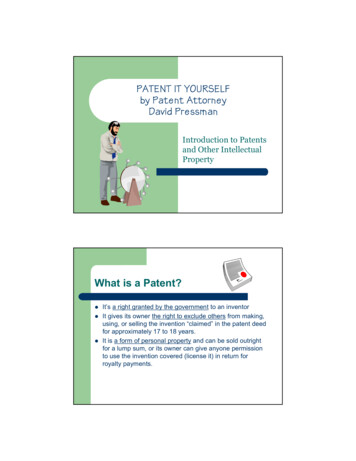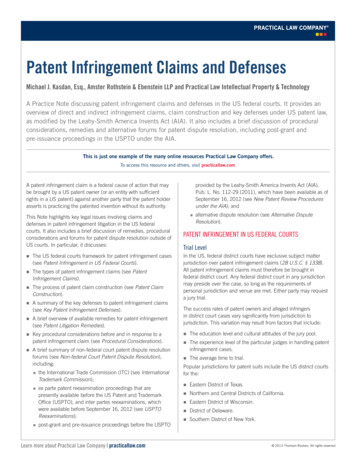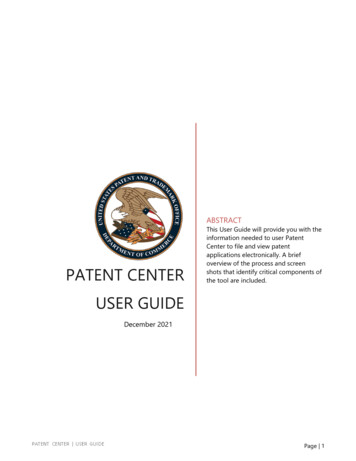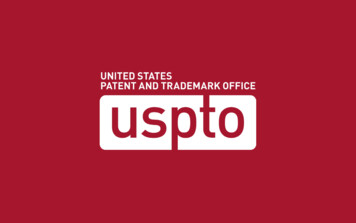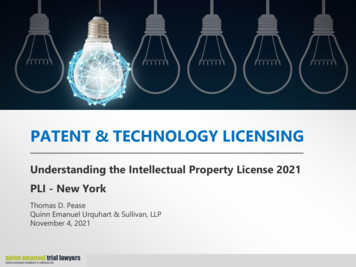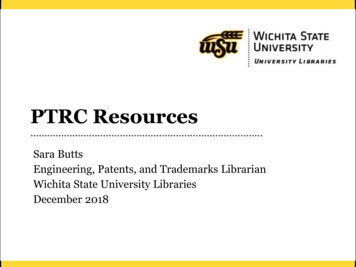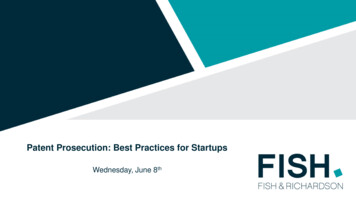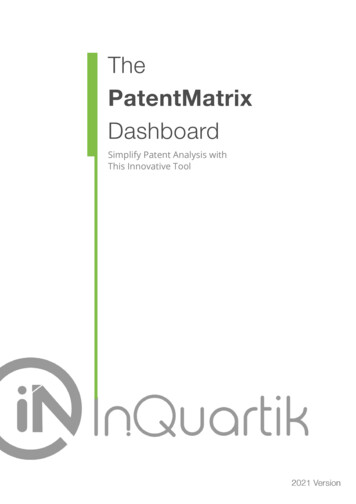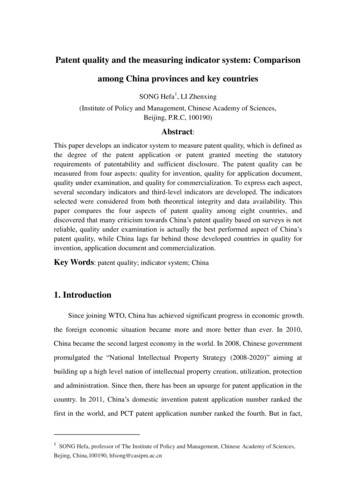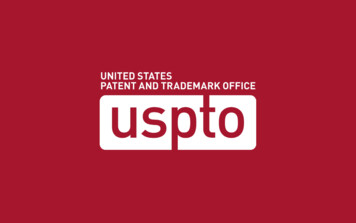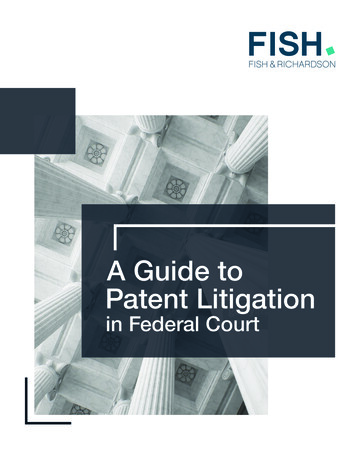
Transcription
A Guide toPatent Litigationin Federal Court
TABLE OF CONTENTSPatent Litigation in Federal Court.3The Complaint.4Response to Complaint.6Post-Grant Patent Office Proceedings.7Case Management Conference.8Fact Discovery.10Expert Discovery.12Claim Construction.14Summary Judgment Motions.15Trial Preparations and Pre-Trial Motions.16Trial.18Appeal.20Settlement.21Editor: Lawrence K. Kolodney2
PATENT LITIGATIONIN FEDERAL COURTLike other forms of business litigation, patent infringement lawsuits are often complex undertakingswith many moving parts, and may be difficult for nonspecialists to understand. Patent cases may beparticularly challenging because they often involve esoteric technology, entail unique litigationprocedures, and raise arcane legal issues. The purpose of this guide is to provide the layperson withan overview of how patent litigation works and what to expect as a case progresses from the initialfiling of the complaint through trial and appeal.What is a patent?A United States patent is a document issued by a federalagency called the United States Patent and TrademarkOffice (USPTO). It gives the patent owner the right toprevent others from making, using, selling, offering to sell,or importing, in the United States, products or methodsthat are covered by the patent, and to collect damagesfrom those who violate that right. Importantly, UnitedStates patents generally do not affect activities outside theUnited States.What are the parts of a patent?A patent typically has three main parts: a cover page, aspecification, and a set of numbered sentences called“claims.” The cover page provides basic information aboutthe patent, such as the patent number, a short summarycalled the “abstract,” the name(s) of the inventor(s), thedate the patent was applied for, and the date the patentwent into effect. The specification provides a detaileddescription, usually with drawings, of how to make anduse the invention(s) covered by the patent, includingdescriptions of one or more specific examples of theinvention, called “embodiments.” The claims, which arelisted at the back of the patent, are legal descriptions ofthe invention(s) covered by the patent, and each claimrecites a set of features or “limitations” that define theessential elements (or “metes and bounds”) ofthe invention.How long dopatents last inthe United States?How are patent rights enforced?Although patents are granted by a government agency,they are enforced only by the private efforts of theirowners. If a patent owner, or “patentee,” believes thatanother party is infringing its patent, the patent owner mayfile a civil lawsuit for patent infringement in a United Statesdistrict court. In order to prevail, the patent owner mustprove that it is more likely than not that the defendantinfringed the patent. An accused infringer may also defeata claim for patent infringement by proving that theasserted patent claims are invalid; for example by showingthat the claims cover technology that existed prior to thepatentee’s own invention (such preexisting technology iscalled “prior art”). If the patent owner is successful inproving infringement (and the defendant fails to prove thepatent claims invalid), the patent owner may ask the courtto award money damages to compensate him/her for theinfringement. In some cases, the patent owner may alsoobtain a court order, called an “injunction,” preventing thedefendant from continuing to infringe. Alternatively, thecourt may order the defendant to pay the patentee aspecified royalty for any future infringing activity.In most cases, the term of a United States patent is 20 years from itseffective filing date. The effective filing date of a patent is the date itwas applied for or, in some cases, the filing date of an earlierapplication by the same inventor(s) that is referenced in the patentand describes the claimed invention(s).3
The ComplaintA patent lawsuit begins when the patent owner (or “plaintiff”) files a document called a “complaint” in afederal district court. The complaint identifies the patent owner and the accused infringer(s), as well as thepatents that are alleged to be infringed. Typically, the complaint includes a high-level description of theactivities of the accused infringer (e.g., making or selling a certain product) that are alleged to infringe thepatents. It also specifies, in general terms, what type of remedy for the alleged infringement is being soughtfrom the court. The complaint is not required to contain any proof that the allegations are true or to revealthe plaintiff’s evidence of infringement. It only needs to put the defendant on notice of the nature of the legalclaims being asserted and the general factual basis for those claims. Once the complaint is filed, the plaintiffmust deliver to the defendant (or “serve”) a copy of the complaint.Pre-Suit InvestigationBefore filing the complaint, the plaintiff’s attorney is required toinvestigate whether there is a good faith, nonfrivolous basis forasserting that the defendant’s actions infringe at least oneclaim of each asserted patent. To be infringing a patent, thedefendant’s activities must involve an accused product ormethod that includes every element or “limitation” recited in atleast one of the patent’s numbered claims. Thus, before filingsuit, the plaintiff’s attorney must perform an infringementanalysis by identifying where each limitation of the claim isfound in an accused product or technology. By signing thecomplaint, the attorney certifies that such an investigationwas conducted.Infringement ClaimsA patent infringement complaint may allege “direct” or“indirect” infringement. Direct infringement occurs when aparty makes, uses, sells, offers to sell, or imports into theUnited States any patented invention. Indirect infringementoccurs when a party intentionally causes or aids another partyto directly infringe. One type of indirect infringement is called“induced infringement,” whereby the indirect infringer “activelyinduces” another to directly infringe, typically by providing thenecessary materials and/or instructions. Another type ofindirect infringement is called “contributory infringement,” whichoccurs when the indirect infringer supplies to others a materialcomponent of a patented invention that is not “a staple article”and is not “suitable for substantial non-infringing use.” When aplaintiff alleges indirect infringement, the specific activitiescausing direct infringement must be identified and the plaintiffmust show that the defendant knew that its activities wouldcause infringement of the specific patent in question—or waswillfully blind to that fact.A complaint may allege “direct”or “indirect” infringement.4
Rule 11By filing a complaint, an attorney certifies thatit is not presented for any improper purpose,lacks frivolous legal arguments, and is likely toeventually garner evidentiary support.— Fed. R. Civ. P. 11Types of ReliefA successful claim for patent infringement entitles the plaintiffto one or more of the following categories of relief: a monetaryaward that compensates the plaintiff for past acts ofinfringement, an injunction prohibiting future infringement, and/or an order requiring payments for future acts of infringement.Because the precise nature of the relief to which the plaintiffmay be entitled is typically not known at the time the complaintis filed, a complaint for patent infringement usually requests ingeneral terms all the categories of relief to which the plaintiffcould be entitled, without specific dollar amounts or specificterms of an injunction.More specific types of relief frequently requested in acomplaint include:Lost Profits: A plaintiff may be entitled to lost profits resultingfrom sales of patented goods or services that the plaintiffwould have made were it not for the defendant’s unauthorizeduse of the patented technology. Generally, lost profits areavailable only when the plantiff sells a product or service thatcompetes with the infriniging product or service, and whenpatented technology is used by the plaintiff to produce or sellgoods, and when the defendant’s customers would havepurchased goods or services from the plaintiff (or purchasedthem at a higher price) were it not for the infringement. In otherwords, the plaintiff must be able to prove that the defendant’sinfringement led to fewer sales (or sales at a lower price) thanwould have occurred but for the infringement.Reasonable Royalty: The patent statute provides that theminimum compensation to which a patentee is entitled from aninfringer is a “reasonable royalty.” This is the amount of moneythat the infringer would have paid in a hypothetical arm’slength bargain to license the patent(s) alleged to be infringed atthe outset of infringement.Injunctive Relief: In addition to a monetary award, a plaintiffmay seek an injunction, which is a court order prohibiting thedefendant from conducting further infringing activities.Typically, an injunction is available if the plaintiff competes withthe defendant and is being harmed in the marketplace by thedefendant’s infringement. A plaintiff may request a preliminaryinjunction to issue at the outset of the case, or a permanentinjunction after a final judgment that the defendant infringed.Enhanced Damages: Courts also have the discretion topenalize culpable conduct of the defendant by awardingenhanced damages up to three times the amount of actualdamages. Enhanced damages are often awarded when theinfringement is found to be willful (i.e., the infringer acted withawareness that it was infringing), but may also be awarded forother types of “egregious” behavior. In situations where suchculpable conduct is present, the complaint should make thatspecific allegation along with a clear request that the courtaward enhanced damages.Reasonable Attorneys’ Fees: Courts have discretion torequire the losing party in a patent infringement suit to pay thelegal fees of the prevailing party “in exceptional cases.” Mostcommonly, this occurs when the defendant is found to havewillfully infringed, the plaintiff’s case is unusually weak, or thelosing party is found to have engaged in misconduct duringthe litigation or in obtaining the patent at issue.5
Response to ComplaintGenerally, a defendant has 21 days to respond to a plaintiff’s complaint after it has been served, althoughthis deadline is often extended by agreement. This response usually takes one of two forms: an “answer” ora motion to dismiss the complaint.AnswerIn an answer, a defendant responds to the factual allegations presented in the plaintiff’s complaint. This is generally done byadmitting to or denying each allegation. Any allegation that is not denied is assumed to be true for the purposes of the litigation.A defendant must also present all of its affirmative defenses to the claims for relief that are contained in the complaint. Anaffirmative defense is one in which the defendant has the burden of proof; for example, a defense that the patent is invalid. Aswith the complaint, the purpose of the answer is to provide notice of the nature of the defenses and not to provide detailed proof.CounterclaimsWhen the defendant answers the complaint, it has the opportunity to include counterclaims, which are requests for relief from thecourt against the plaintiff. In effect, they constitute the defendant suing the plaintiff. For that reason, the defendant in the litigationmay also be considered to be the “counterclaim plaintiff.” And just as the defendant has 21 days to respond to the plaintiff’scomplaint, the plaintiff has 21 days to respond to the defendant’s counterclaims. Further, like the plaintiff, the defendant musthave a good faith, nonfrivolous basis for its counterclaims. In patent cases, it is common for the defendant to assert ascounterclaims requests for declarations that the patent is not infringed and/or is invalid. Less frequently, the defendant willinclude counterclaims asserting that the plaintiff infringes the defendant’s own patents, or some other legal claim againstthe plaintiff.Motions to DismissIn some instances, it may be appropriate for the defendant to ask the court to dismiss the lawsuit at the outset, without everconsidering the evidence in support of the plaintiff’s claim. In patent cases, such motions most commonly involve (1) an assertionthat the court lacks personal jurisdiction over the defendant because the defendant lacks sufficient contacts with the state inwhich the court is located, or because the plaintiff failed to serve the complaint properly on the defendant; (2) an assertion thatthe lawsuit was filed in the wrong court because the defendant does not have a place of business in the district and is notincorporated in the state where the court sits; (3) an assertion that the plaintiff is not the true owner of the patent and thus lacksstanding to bring the suit; (4) an assertion that the complaint does not include enough factual details to make out a plausibleclaim for infringement; or (5) an assertion that the asserted patent is invalid on its face (e.g., because it purports to claimunpatentable subject matter, such as an abstract idea).If the defendant files a motion to dismiss within the 21-day period for responding to the complaint (including any extensions), it isnot required to file its answer until the court rules on the motion. If the court rules on the motion but does not dismiss thecomplaint, the defendant has 14 days to file its answer.A defendant’s response tothe complaint takes one oftwo forms:1. An “answer” (which mayalso include counterclaims)2. A motion to dismisspursuant to Rule 12(b) ofthe Federal Rules ofCivil Procedure6
Post-Grant Patent Office ProceedingsAlthough patent litigation trials take place in federal district courts, it is commonplace for defendantsin patent lawsuits to also initiate parallel proceedings in the USPTO, challenging the validity of the assertedpatents. These are generally referred to as “post-grant” proceedings because they takeplace in the USPTO after the patent has already been granted.The most common post-grant proceeding is called inter partes review (IPR) and involves a challenge to the validity of a patentbased on patents or printed publications that predate the patent’s filing date. Requests to initiate an IPR (called “petitions”) maybe filed by a defendant up to one year after being served with a patent infringement complaint. They may also be filedpreemptively, before any lawsuit has been initiated. A successful IPR can invalidate one or more patent claims. Once an IPR hasbeen completed, it precludes the defendant’s continuing to assert in the lawsuit any invalidity defenses that were or could havebeen brought in the IPR. This is called “estoppel.”Another common type of litigation-related proceeding is called a covered business method (CBM) patent review. CBMproceedings apply only to “business method” patents and generally allow a broader range of challenges to the validity of thepatent. Unlike IPRs, they are not subject to a one-year filing limitation and do not prevent the defendant from using defenses at alater trial that could have been, but were not, asserted in the CBM.Once an IPR or CBM has been filed, it is common for the defendant to ask the district court to stay (i.e., temporarily halt) theunderlying patent suit pending the outcome of the proceeding at the USPTO. By statute, IPRs and CBMs must be completedwithin 18 months of the challenger’s initial request (with rare exceptions), and because the result of the IPR or CBM maysubstantially simplify the case, many judges will agree to issue such stays. If the IPR or CBM invalidates all of the asserted patentclaims, this effectively ends the lawsuit.Other types of post-grant proceedings available at the USPTO include post-grant review, ex parte reexamination, supplementalexamination, and derivation proceedings. However, these are rarely used in connection with litigation. The following chartsummarizes the differences between the types of post-grant proceedings.ProceedingInter equired Showingby DefendantGrounds forChallengingEstoppel? Patents Publishedpatent apps PrintedpublicationsRaised orreasonably couldhave raised More likely than not thatat least one claim isunpatentable Petitioner suedor “charged withinfringement”Any invalidity groundNarrow:Raised (Civil) ORboth raised orreasonably couldhave raised(USPTO)More likely than notthat at least one claimis unpatentable ORimportant novel/unsettledlegal questionAny invalidityground under 35U.S.C § 282 (exceptbest mode)Raised orreasonably couldhave raisedSubstantial new questionof patentability Patents Publishedpatent apps PrintedpublicationsNo legalestoppelWho May SeekWhen It May Be UsedAnyone other thanpatent owner Available starting September 16, 2012 Applies to all patents at the later of: Nine months after issue, or After the date of termination of thepost-grant review (if applicable)Reasonable likelihoodthat petitioner wouldprevail on at least onechallenged claimAnyone other thanpatent owner Available starting September 16, 2012and until September 15, 2020 Applies to all patents related to“financial product or service” butexcludes “technological innovations”Anyone other thanpatent owner Available as of September 16, 2012 Applies to all patents having a claimwith priority date on or after March 16,2013, within nine months of issueEx ParteReviewAnyoneSupplementalExaminationPatent owner only Available as of September 16, 2012 Applies to all patentsSubstantial new questionof patentability wouldresult in Ex ParteReexamination by PTOAny informationN/ADerivationProceedingInventor onlyApplies to all claims with priority dateson or after March 16, 2013 (interferenceremains available for others)Claimed invention derivedfrom anotherN/AN/AAvailable7
Case Management ConferenceAfter the complaint has been served on the defendant, the presiding judge will schedule a meeting with thelawyers for the parties, which is called the case management conference (or sometimes the initial pre-trialconference or scheduling conference). The purpose of this meeting is to lay out the ground rules that willgovern how the case will go forward. To that end, the lawyers for the plaintiff and defendant are required to“meet and confer” prior to the conference to try to narrow down any disputes about those ground rulesthat might need to be resolved by the judge. While a variety of issues may be discussed and decided at thecase management conference, the most common include the following:SchedulingThe primary purpose of the case management conference is to set the case schedule. The case schedule will determine howlong the parties have to engage in discovery and when certain types of disclosures (such as a detailed explanation ofinfringement or invalidity contentions) must be provided. Depending on the judge and court, the case schedule may also includea specific date or range of dates when the trial will occur. Some judges will wait until discovery has been completed to schedulethe trial date. The time it takes for a case to get to trial can vary dramatically—typically from one to three years—depending onthe complexity of the case and the court’s own schedule.Discovery LimitsDiscovery is the process by which the parties to a lawsuit investigate the facts of the case, primarily by asking the opposing partyto provide copies of documents (including electronically stored information), answer written questions called “interrogatories,” andgive sworn testimony in depositions. While the court rules provide some default limits on the amount of discovery that each partymay seek, it is common for one or both parties to request that the court modify or supplement those limitations. The mostsignificant discovery limit at issue is usually the maximum number of depositions (or hours of deposition) that each party canrequire witnesses for the other party to provide.Electronically Stored InformationAnother issue sometimes addressed at the case management conference is how to conduct discovery of electronically storedinformation (ESI), which includes e-mails, electronic files, and databases, among other things. Each party may ask the opposingparty to provide ESI that relates to the issues in the case. However, given the enormous volume of ESI that most companiesmaintain, it is often not practical for parties to review all the potentially relevant ESI in their possession. Instead, the parties willusually negotiate limits on what types of ESI must be searched and produced, and how the searching should be conducted. Forexample, the parties may agree, or the court may order, that documents from only a limited number of employees, or from alimited time frame, need to be searched, or that searching may be done using keywords negotiated by the parties. Practicallyspeaking, the issue that is most frequently disputed is how to conduct the search for and production of e-mail.At the case management conference,the judge will set out ground rules concerning:18The caseschedule2The scopeof discovery3How to handle theparties’ electronicallystored information4How to handleconfidentialinformation
Case management conferences also give the parties the opportunity todiscuss alternative dispute resolution, often in the form of mediation, asa way to resolve the case without going to trial. In mediation, the partiesmeet with a neutral third party who helps negotiate a settlement of the case.Protective OrderIn addition to a case scheduling order, the judge in a patent case will usually issue a“protective order” that safeguards the parties’ confidential information that must beprovided to opposing counsel during discovery by limiting who may have access to thatinformation, and by prohibiting those with access from further disclosing it. As withdiscovery limits, the terms of this order are usually negotiated by the parties in advance ofthe case management conference, with the judge resolving any issues for which there isdisagreement. Three issues are most often debated when negotiating a protective order:Access: Some parties may want their in-house attorneys and employees to haveaccess to the opposing parties’ information in order to assess the merits of the case,while other litigants may want to ensure that their own confidential information does notmake it into the hands of employees of the opposing party. One way to handle thisissue is to create tiers of confidentiality such that the most sensitive documents can beviewed only by outside counsel, while other, less sensitive documents may also beviewed by certain in-house personnel.Source Code: Because parties may be especially concerned about unauthorizeddisclosure of computer source code, protective orders sometimes specify specialprocedures for source code inspection. For example, a protective order may includerestrictions such as the location of any inspection, what items may be brought into theinspection room, and limits on the number of pages of source code that may beprinted.Prosecution Bars: A patent “prosecution bar” is a provision that bars individuals whohave received confidential information from prosecuting patent claims at the USPTOconcerning the same subject matter. Defendants often seek prosecution bars toprevent the plaintiff from using the defendant’s confidential information to obtain patentclaims that specifically target the defendant’s products. The precise scope of thesubject matter covered by the prosecution bar, and whether or not it should apply topost-grant proceedings, is often contested.Stipulations to Simplify CaseBeyond limits on discovery, litigants may negotiate the scope of the issues that will beconsidered in the case. For example, litigants may limit the number of asserted patent claims,the volume of prior art that will be considered for a validity challenge, or the number of claimterms to be construed.MediationMany judges will explore the possibility of mediating the parties’ dispute at the casemanagement conference. Frequently, the court will ask the parties if they are prepared tomediate the case and may propose a mediator associated with the court (e.g., a magistratejudge). In some courts, the parties are required to participate in some form of mediation—whether before a judge, magistrate, or third-party mediator—prior to trial, and the court will seta deadline for this mediation to occur.9
Fact DiscoveryAfter the case management conference, the periodfor fact discovery begins. Fact discovery is theprocess through which each party may obtainevidence and information from the opposing party,or from third parties, that is relevant to the case. Thisprocess is an opportunity for each party to obtainevidence supporting its case while at the same timelearning about the positions and supportingevidence of the opposing party. In a patent case, thefact discovery period may last from six months toseveral years, depending on the complexity of thecase and the court’s schedule. In general, theparties may seek discovery on any matter that isrelevant to any claim or defense in the case and notprotected by attorney-client privilege.There are several ways for the parties to discover evidencefrom each other and third parties:InterrogatoriesInterrogatories are written questions served on an opponent,asking for written answers in response. The party receivingthe interrogatory must respond within 30 days, by providingwritten answers, by identifying documents that contain theanswers, or by objecting to the interrogatory. Often a partywill object to an interrogatory as “premature” and thenprovide a substantive response closer to the end of thediscovery period. If the parties are unable to resolve disputesabout the proper scope of interrogatories and/or theadequacy of answers to interrogatories, they may seek aruling from the court to resolve the issue.Requests for AdmissionRequests for admission are written statements that one partyprovides to another party, asking it to admit that eachstatement is true. The responding party must admit or denythe truth of each statement, or state that it lacks sufficientevidence or knowledge to admit or deny the statement.Requests for admission are useful for identifying trulyundisputed facts that need not be proved at trial, thus helpingstreamline the trial. For example, they can be used to showthat particular documents are authentic, or to identify theclaim limitations that a party agrees are present in an allegedlyinfringing product or prior art reference.Requests for ProductionRequests for production are written requests for copies ofdocuments, ESI, tangible objects, or inspection of physicallocations. The party receiving the request must respond inwriting within 30 days by stating whether it will provide therequested information or will object to the request asoverbroad. The requested information is then usually providedsometime later, and oftentimes on a rolling basis as theresponding party continues to collect documents within thescope of the request.A party may use subpoenas to obtain discovery fromthird parties by requiring them to produce documentsor appear at depositions.10
DepositionsDepositions are out-of-court proceedings during which awitness responds under oath to questions presented by anattorney. The deposition testimony is recorded by a courtreporter and/or by videotape for later use in court. A party mayrequest to take the deposition of specific employees of anopposing party, or it may ask an opposing party that is acorporation or other organization to supply a witness preparedto testify about the party’s knowledge of specified subjects.SubpoenasWhile most fact discovery involves the plaintiff or defendant, itis sometimes necessary to obtain information from a non-partyto the case. Parties may obtain discovery from non-parties byserving the non-parties with a “subpoena,” a court orderrequiring the non-party to provide information. Typically,subpoenas are used to compel non-parties to producedocuments or to provide a witness for a deposition. The scopeof discovery from non-parties is generally more limited thanwhat may be obtained from parties, and may be limited bycourt order if it is overly burdensome on the non-party.Infringement and Invalidity ContentionsIn some courts, a mandatory part of fact discovery involves anexchange by the parties of detailed “contention” documents,whereby the plaintiff provides the defendant with a detailedexplanation of how it believes the defendant is infringing thepatents-in-suit, and the defendant provides a detailedexplanation of why it contends that the patents are invalid. Theexchange of these contentions typically takes place early in thediscovery period, thereby limiting the scope of furtherdiscovery to information that is relevant to the contentions.Typically, the infringement contentions will identify the specificpatent claims that the plaintiff contends are infringed, and willalso include “claim charts” that identify, for each element ofeach asserted claim, where that element is found in thedefendant’s accused product or method. Similarly, theinvalidity contentions will identify the basis for the defendant’svalidity challenge, and will include claim charts that identifywhere each claim element is found i
A patent typically has three main parts: a cover page, a specification, and a set of numbered sentences called "claims." The cover page provides basic information about the patent, such as the patent number, a short summary called the "abstract," the name(s) of the inventor(s), the date the patent was applied for, and the date the patent
